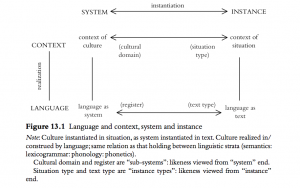Halliday on context: the relations of realization and instantiation
To understand Halliday’s use of terms like ‘context of situation’ and ‘context of culture’, they have to be reconciled with other key terms in Halliday’s theory. Two key papers help us to see how Halliday fills out the notions of context of situation and, perhaps even more so, the context of culture. They show how these concepts need to be interpreted in relation to other vantage points in his theory.
These papers are:
1. The History of a Sentence (Halliday 1992)
and
2. The notion of ‘context’ in language education (Halliday 1991)
1. In The History of a Sentence (Halliday 1992 explores dimensions in the history of meaning of semiotic events. Halliday argues that “An event, however small, has a history” (1992[2003]: 356) and that “There is, so to speak, a history of meaning, and the interpretation of any act of meaning must rest on other such acts that have preceded it and created the conditions for its occurrence” 1992[2003]: 358). Halliday proposes “four strands or dimensions of history that are forerunners of every sentence by virtue of the fact that it is an act of meaning.” These dimensions, I would suggest, are forms of ‘contextualising’, that establish a way of interpreting the notion of ‘context of culture’. They are:
1. Intertextual history
2. Developmental history
3. Systemic history
4. Intratextual history
Summarising these dimensions, Halliday argues “The impact of a text is dependent on its location in this complex semo-history, at the intersection of the various dimensions of that history where we ourselves are located when we enact it or hold it up for investigation” (1992[2003]: 373).
I talk through this paper here:
The history of a sentence_PART 1 from Annabelle Lukin on Vimeo.
The history of a sentence PART 2 from Annabelle Lukin on Vimeo.
2. The second paper is “The notion of ‘context’ in language education“, first published in 1991, then republished in Volume 9 of Halliday’s Collected Works. As the name suggests, the focus of the paper is language education – but, as Halliday argues, language is implicated in all education. To relate the notion of “context” to language education, Halliday recounts its theoretical development, through Malinowski and Firth. He argues that both scholars focused on the situation as the context for the text. He then notes that Firth was not much interested in the notion of ‘context of culture’ – but that in the linguistics of Sapir and Whorf, we find a preoccupation with the relations between language as a system and the cultural context, on the idea of ‘culture’ as the context for language. From Sapir and Whorf we see that:
“language evolved as part – moreover the most unconscious part – of every human culture, it functioned as the primary means whereby the deepest perception of the members, their joint construction of shared experience into social reality, were constantly reaffirmed and transmitted. Thus in this sense the culture provided the context within which words and, more generally, grammatical systems were interpreted” (Halliday 1991[2007]: 273).
Halliday brings text and situation, language and culture together, theoretically, in the representation below (Halliday 1991[2007]). The vector of ‘instantiation’ (along the horizontal dimension) relates ‘context of situation’ to ‘context of culture’. Halliday explains that:
“A situation, as we are envisaging it, is simply an instance of culture; or, to put it the other way round, a culture is the potential behind all the different types of situation that occur. We can perhaps use an analogy from the physical world; the difference between “culture” and “situation” is rather like that between the “climate” and the “weather”. Climate and weather are not two different things; they are the same thing, which we call weather when we are looking at it close up, and climate when we are looking at it from a distance” (1991[2007]: 276).
The text is in the same way an instance of the language system. The relation of ‘realization’ (along the vertical dimension) relates ‘text’ to ‘situation’, and ‘language’ to ‘culture’.
I talk through this paper here:
The notion of ‘Context’ in language education PART 1 from Annabelle Lukin on Vimeo.
The notion of ‘Context’ in language education PART 2 from Annabelle Lukin on Vimeo.

